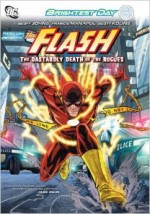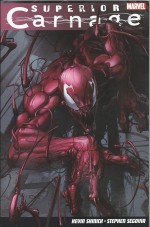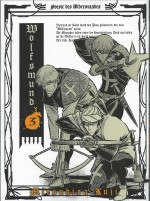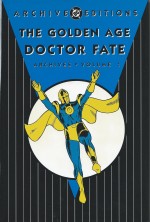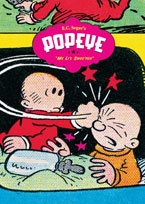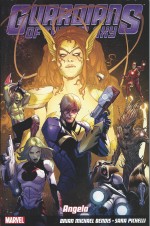
By Brian Michael Bendis with Neil Gaiman, Sara Pichelli, Olivier Coipel, Valerio Schiti, Francesco Francavilla, Kevin Maguire & Mark Morales (Marvel/Panini UK)
ISBN: 978-1-84653-570-3
Since its momentous rebirth in the early 1960s Marvel Comics was synonymous with making superheroes more realistic. However the little publisher always maintained a close connection with the fantastic space-opera and outrageous cosmic calamity that typified its pre-renaissance – as cherished by oldsters like me who grew up reading their “Hairy-underpants Monsters from Beyond†stuff.
With Space bigger than ever (a little cosmology humour there), one of the resurgent company’s earliest concepts has had a major revamp and now ranks as one of the most entertaining titles to come out of 2012’s MarvelNow! group-wide reboot.
There’s even a major blockbuster movie scheduled for release this August…
The Guardians of the Galaxy were created by Arnold Drake and Gene Colan for try-out title Marvel Super-Heroes (#18, January 1969): a band of freedom fighters dedicated to liberating star-scattered Mankind from domination by the sinister, reptilian Brotherhood of Badoon.
A rare “miss†for the creatively on-fire publisher, they then vanished into limbo until 1974, when Steve Gerber incorporated them into Marvel Two-In-One, Giant Size Defenders and The Defenders, wherein assorted 20th century champions travelled a millennium into the future to ensure humanity’s liberation and survival.
This led to the Guardians’ own short-lived series in Marvel Presents (February 1976-August 1977) before premature cancellation again left them floating around the Marvel Universe as perennial guest-stars for such cosmically-tinged titles as Thor, Marvel Team-Up, Marvel Two-in-One and The Avengers.
In 1990 they secured a relatively successful second series (#62 issues, annuals and spin-off miniseries) before cancellation struck again in July 1995.
This isn’t them; that Future was a Prelude…
In 2006 a monumental crossover epic involved most of Marvel’s 21st century space stars in an “Annihilation†Event, and led writing team Dan Abnett & Andy Lanning to reconfigure the Guardians concept for contemporary times and tastes.
Amongst the stalwarts initially in play were Silver Surfer, Galactus, Firelord, Quasar, Nova, Thanos, Star-Lord, Moondragon, Super-Skrull, Gamora, Ronan the Accuser, Drax the Destroyer and a host of previously established alien civilisations such as the Kree, Skrulls, Watchers, Xandarians, Shi’ar et al., all falling before a invasion of rapacious Negative Zone beasties unleashed by undying horror Annihilus.
The saga spawned specials, miniseries and new titles (subsequently collected in many volumes) and inevitably led to a follow-up event…
In Annihilation: Conquest, the cast expanded to tackle new threat, adding – and sometimes subtracting – such interstellar luminaries as Adam Warlock, the Inhumans, Kang the Conqueror, Blastaar, the Magus, Captain Universe, fallen Celestial Madonna Mantis, anamorphic adventurer Rocket Raccoon and gloriously whacky “Kirby Kritter†Groot, a walking killer tree and one-time “Monarch of Planet Xâ€, amongst others…
I’ve covered part of that cataclysmic clash elsewhere and will get to the rest one day: suffice to say that by the end of the successive Annihilations and subsequent intergalactic War of Kings, a new, pan-species Guardian group had appointed itself to defend the recovering civilisations and prevent such calamities from ever happening again.
This isn’t them either… not so much…
A few years later and many more cosmic crises, the remnants of those many Sentinels of the Spaceways got the band back together, still determined to make the universe a safe place (for specifics you should consult Guardians of the Galaxy volume 1: Cosmic Avengers).
Thus this second compelling chronicle (collecting Guardians of the Galaxy volume 2 #4-10 from July 2013-January 2014) resumes the immensely absorbing interstellar interactions of a bunch of alien freaks and the human heroes who fight beside – when not actually with – them. Moreover, this time it all ties neatly into the overarching mainstream Marvel continuity…
Brian Michael Bendis continues the tale of Peter Jason Quill – half-breed Terran son of J’Son of Spartax: undisputed ruler of an interstellar empire but no friend of Earth – and his allies in pacifying an unruly and unforgiving universe as Drax, Rocket Racoon, Groot and Gamora (“Deadliest Woman in the Galaxyâ€) spend some downtime in a bar with their newest recruit, Tony Stark…
Iron Man had been spending time exploring the universe and become embroiled in the self-appointed Guardians’ ongoing trouble with a compact of major cosmic powers and principalities. A coterie of these had formed a Council of Galactic Empires and unilaterally declared Earth “off limitsâ€: quarantined from all extraterrestrial contact.
That high-minded declaration hadn’t stopped one of the Signatories – the scurrilous reptilian Brotherhood of Badoon – from launching a sneak attack on London and being soundly thrashed by Quill, Stark and Co…
After open-minded “Ladies Man†Stark scores an amatory epic fail with Gamora (a wry episode which delivers plenty of laughs for his new comrades who can’t let it lie for the rest of the book), the viridian virago storms out to cool off and is ambushed by an alien bounty hunter.
Despite her formidable prowess she is only saved by the arrival of the Guardians who have just finished trashing a bar and the squad of Spartax soldiers who walked in on their drunken carousing…
With no information on who else now wants them dead, the disparate legion of the lost head back into space and a fateful dalliance with destiny…
Still being crushingly snubbed by Gamora, Stark occupies himself learning new ways to repair his comparatively primitive armour under the guidance of the aggravatingly disparaging racoon whilst Quill takes a secret meeting in one of the universe’s many unsavoury, unwelcoming armpits.
Starlord’s consultation with former ally Mantis about a bizarre episode (wherein he seemed to experience an inexplicable and debilitating chronal mindquake) provides no answers and he is forced to go ask the last person in creation he ever wanted to see again…
Meanwhile, Stark and the remaining Guardians have spotted an unidentifiable lifeform approaching Earth and rush to incept her before she can do any damage…
They reason they can’t identify her is because she’s from another universe and time. Angela (created by Neil Gaiman for Spawn #9 in 1993 and, after much legal foofawraw, brought under Marvel’s auspices in Age of Ultron) is lost and baffled, approaching a world her people have always considered a fairytale or religious myth when the still disgruntled Gamora smashes her into the moon, grateful for an excuse to work off her pent-up hostilities…
The satellite’s oldest inhabitant – Uatu the Watcher – is reeling from the conflict. Not because of its savage intensity but because he knows what Angela is and how she simply cannot be present in this Reality…
Quill however is pumping the mad Titan Thanos for information on his own time troubles and realises he has just poked the biggest bear in existence. The Death-Lover declares that humanity’s perpetual tampering with the time-stream has broken the universe and brought our pathetic mud-ball to the attention of races and powers that won’t let Mankind muck up Reality any longer…
Rushing back to his birthworld, Star-Lord finds his team faring very badly against the mysterious Angela and pitches in. When she is finally, spectacularly subdued, Uatu appears and proffers dire warnings for all Reality…
With uncharacteristic diplomacy Quill then coaxes the enigmatic intruder into relating her story. Apparently she’s a Hunting Angel from a place called Heven, fallen through a gaping crack in Everything That Is…
Drawn to Earth – a place her race reveres but considers a beautiful fiction – she was ambushed by Gamora, who cannot believe Star-Lord’s next move: freeing Angela and, after personally conducting her on a tour of the world, letting her go free…
At this time almost all of Marvel’s titles had been building to a big Avengers-centric crossover event dubbed Infinity, and the next two issues (#8-9, stunningly illustrated by Francesco Francavilla) form the Guardians’ contribution to the epic, in which a double crisis afflicts our particular portion of space.
As Thanos invades Earth for his own dark personal motives, an ancient spread of races from far beyond attack those stellar empires still recovering from the Annihilation outrages and the War of Kings. It’s nothing personal: this invading alien Armada is tasked with eradicating every Earth in every dimension and the Kree, Skrulls, Badoon, Galadorians, Spartax, Shi’ar and all the rest are simply guilty of associating with humans…
With all the Avengers called into space to fight beside their former enemies, Earth is helpless when enemy E.T.’s overwhelm The Peak (the planet’s orbital defence citadel) and Abigail Brand – Director of the Sentient World Observation & Response Department – sends a desperate distress call to Star-Lord.
His affirmative answer enrages Gamora, already bristling from the knowledge Quill has been fraternising with the despised Thanos and she quits…
With Iron Man also gone, Star-Lord, Groot and the Raccoon sneakily infiltrate the station (Drax doesn’t do unobtrusive) but quickly fall foul of the superior forces and only the sudden return of Angela saves the day. When Gamora and Drax then join the fray the Guardians are magnificently triumphant… but at a terrible cost…
This volume then closes with a far-lighter “Girls Night Out-rageous†(#10, illustrated by Kevin Maguire) as Gamora and Angela enjoy a blistering bonding session and action-comedy moment whilst visiting the Badoon homeworld Moord, freeing the reptilians’ vast contingent of enslaved races and accidentally uncovering an impossible connection between the scurvy raider race and Angela’s dimensionally displaced people…
Bright, breezy, bombastic and immensely enjoyable, the Guardians of the Galaxy offer fast and furious adventure and captivating thrills, spills and chills, and this volume also includes a beautiful gallery of two dozen covers-&-variants by Pichelli & Justin Ponsor, Adi Granov, J. Scott Campbell, Julian Totino Tedesco, Brandon Peterson, Francavilla, John Tyler Christopher, Maguire, Paul Renaud, Skottie Young, Mike Deodato Jr., Terry Dodson, Milo Manara, Paolo Manuel Rivera, Mark Brooks, Leonel Castellani and Adam Kubert plus a wealth of as-standard added extras provided by a multitude of AR icon sections (Marvel Augmented Reality App) offering story bonuses once you download the free code from marvel.com onto your smart-phone or Android-enabled tablet.
™ & © 2013 and 2014 Marvel & Subs. Licensed by Marvel Characters B.V. through Panini S.p.A. All rights reserved. A British Edition published by Panini Publishing, a division of Panini UK, Ltd.

